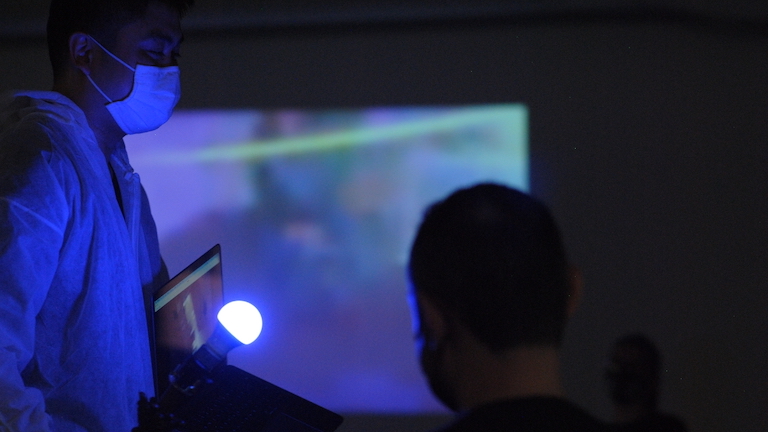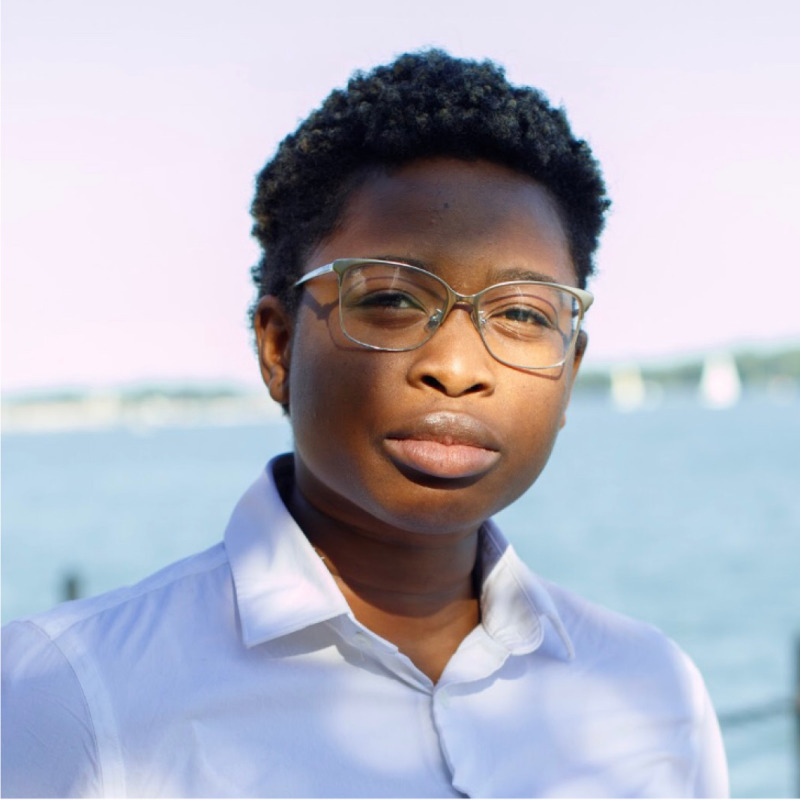In conversation with Clayton Lee and Michael Rubenfeld from ‘Ways of Being’

Ways of Being was an interactive performance for two different groups of audience, in two different cities simultaneously. Returning to Kingston as a part of FOLDA 2022, the work transformed me into both the performer and audience, spectator and entertainer.
And as someone interested in the human condition, Ways of Being gave me the space to explore and understand, “How do we become the people we are at any given moment? Why are we like this?” While the piece did not give me my answers, creators Clayton Lee and Michael Rubenfeld (otherwise known as Selfconscious Productions) did.
Note: Ways of Being was co-presented with the Kick & Push Festival. This interview has been edited for clarity and length.
What is a social media interaction that you just can’t forget about?
Clayton Lee: I mean, so many and yet nothing is coming to mind. I’m actually really obsessed with the way that the Pride Month tweet has been going around like, “Oh, I’m a straight person, but a lot of people think I’m gay. This month, I’m partnering with `I Can’t Believe It’s Not Butter’.”
Michael Rubenfeld: There’s been so many right, Clayton? I once had a reviewer for Time Out London quote me a few years ago. The thing that he quoted me on ended up going viral for him. I thought that was pretty cool. He got the clout, but it was my quote.
What about Ways of Being would you want people to know about?
Clayton: The work is two performers in two separate cities, with their own audiences, attempting to conjure the feeling of connections between and among these two theatrical spaces. That’s the work in a nutshell.
What type of theatre is this exactly – what is the form?
Clayton: Within the Canadian language, it’s still theatre/performance. Michael thinks about it as live art, which is kind of more of the UK context.
What were you surprised to be able to do during the run?
Clayton: The previous version of the work was a complete disaster. Our internet used to cut out halfway through the show and I just had to explain on the microphone what was supposed to be happening because our ancient technology was just not what we actually needed.
Michael: We were sort of surprised that we were able to solve a lot of the sound problems. I think there was this really great feeling on the Friday for us after that show. Because we’ve spent so much time working on the technology and seeing if we can just realize a vision. Can we make it work, like can this actually work? Because we don’t really know anything about technology! And so we were relying on our collaborators to help solve some of our questions with us. And on Friday, it really felt like, “Okay, this is possible.” And I didn’t feel terrified. It was funny because on Saturday, I was like, “This is gonna go great!” And then things started to fall apart. But for me, that felt like a real victory. We want to continue to work on it, and it didn’t kill our relationship. Which is interesting, as an accomplishment, to say that that’s part of the intention in the work, to bring us closer together.
Clayton: I think we’ve become accustomed to a certain type of presentation in which things are easy. Watching people meeting for the first time and navigating through those situations–it’s not always tidy. It’s not always easy. I wouldn’t say it’s complicated, but it has nuance to it. In the performance on the Saturday, you are forced to watch a masked audience interact with an unmasked audience. That’s a core part of the work: we are thinking about the ways connection begins. How do you sit with these discomforts, but also allow for the really kind of wonderful moments of surprise?
What is the relationship to trust within the piece? And how far do you, or we as audience, let it go?
Clayton: I allow it to go quite far. It’s never gone out of control. I’m always interested in moments lasting a bit longer than you’d expect. I think the hard part of the piece for me is actually as a performer, putting trust at the foreground of the work. I think often theater creators are so obsessed with controlling the situation and controlling the parameters because they’re afraid of boredom, or discomfort, or they’re afraid of, whatever! Part of the strategy and laying that out at the very beginning is to create a sense of comfort amongst the audience and performer, or to attempt to maybe even conflate or collapse the two together. In my performance there are times when the audience members come forward, and I become an audience member. It’s really about creating an environment where people feel like that’s possible.
In this conversation about trust, are there moments in which you would ever lie, or fabricate reality for the audience?
Michael: I don’t know. It’s a good question. I’m not sure. I mean, what are the things that we do to build connections between people, and what are the different possibilities? We’re asking people to have a dance party or asking them to do a bunch of things that they wouldn’t necessarily do, but we’re asking them to do that with us to try and build feelings of connection. I guess the question for me is always about intention. So if we were to fabricate and lie to an audience… there’s a place for everything. But what would that do? What would it be?
The work exists on many different planes, different cities, through the digital world – where do you think the legibility and understanding of the work sits?
Clayton: I don’t think about world building in this kind of way. The kind of planes that we’re operating on intentionally feel like real life. There’s this book called Glitch Feminism by Legacy Russell, who talks about our relationship to the internet and how this phrase ‘IRL’ is so empty because you can, in fact, have a real life on the internet. She often prefers to use ‘AFK’ or ‘away from keyboard’ to describe a non-digital space. For me, the work is still real whether we’re going to accent the digital or physical. With each of them, we become different parts of ourselves. It all exists in continuum, we’re always navigating our comfort levels while relating with other people in spaces we are not comfortable in.
Michael: We don’t want it to feel like it fits in one place in particular. We talked about it, feeling like [Ways of Being] operates for the times that we’re in. When we first started the piece, it was also a different time, a different COVID time, and it may go back to another COVID time. I feel that we started with a super set of tools, and then thought, “What are different modalities of existence within the context of the tools that we’re working with right now?” We wanted to find a way to use the internet, to connect people in ways that would respond to what I think of as extreme exhaustion, is finding a hybrid. What does it mean for a piece to feel original? And I don’t really believe that anything is original, necessarily, but I think that things can feel as if they’re original.
How did the thesis of the piece change over time?
Michael: Frustratingly, Kingston’s still in masks. The first time we did it, we weren’t in masks in Krakow, and we weren’t in masks this time. Kingston was in masks both times. What’s interesting is that the first time around, people were like: “Oh, yeah, okay, that makes sense that they’re still in masks”. People had accepted it. But this time around, both audiences found it completely scandalous that everyone was still in masks in Kingston. I had more conversations about that than anything else. People just could not believe that everyone was still wearing masks indoors. Or that was still a thing because, basically once the war began, it was like COVID ended in this part of the world.
Clayton: I think the world inevitably changes the work enough based on who activates it both as a performer and audience members, because everyone’s relationship to the Clayton in place contributes to the work. We have maybe five lines of dialogue that are planned and everything else is made up on the spot.
Were there any ideas that you had to leave out? Anything you wish you could bring back?
Clayton: Frank Donato was our lighting and video designer for the work. The montage was his own creation. In the original impetus for the work, we wanted the final moment to feel extremely theatrical. My idea for the previous version was to have a big light cue, and also a leaf blower blowing confetti around the space. It didn’t make sense, given the effectiveness of that final montage, but blowing confetti around is so funny to me. So perhaps for another day.
Michael: There’s this section where we turn off all the lights, and when we do this we do the sound[scape]. We actually changed this on Saturday, and we tried something new. I think there’s this desire to conjure a specific feeling in the room at that section. Using sound somehow, but I don’t think we’ve fully figured it out yet. I feel like we got closer on the second day, even though it was not as technically as good as the Friday show. But I had a desire for a kind of cheesy karaoke moment with everyone. I knew it would please everybody, because people like to do karaoke even if it sounds bad. The dance moment, as silly as it is, becomes a bit of a dance party in the middle of the room here, because of how the cameras are set up. And it’s really cool. And people love it. People just love it.
Co-presented with The Kick & Push Festival, Selfconscious Production’s Ways of Being ran June 10 and 11 at FoLDA 2022. Click here to read our review on its presentation last year at the Tett Centre.
